Transconjunctival Inferior Orbitotomy: Indications, Surgical Technique, and Complications
Abstract
:Indications
Technique
Complications
Conclusion
References
- Wray, R.C.; Holtmann, B.; Ribaudo, J.M.; Keiter, J.; Weeks, P.M. A comparison of conjunctival and subciliary incisions for orbital fractures. Br J Plast Surg 1977, 30, 142–145. [Google Scholar] [CrossRef] [PubMed]
- Holtmann, B.; Wray, R.C.; Little, A.G. A randomized comparison of four incisions for orbital fractures. Plast Reconstr Surg 1981, 67, 731–737. [Google Scholar] [CrossRef] [PubMed]
- Kushner, G.M. Surgical approaches to the infraorbital rim and orbital floor: The case for the transconjunctival approach. J Oral Maxillofac Surg 2006, 64, 108–110. [Google Scholar] [CrossRef]
- Bourget, J. Les hernies graisseuses de l’orbite. Notre traitement chirurgical. Bull Acad Nat Med 1924, 92, 1227–1232. [Google Scholar]
- Tessier, P. The conjunctival approach to the orbital floor and maxilla in congenital malformation and trauma. J Maxillofac Surg 1973, 1, 3–8. [Google Scholar] [CrossRef] [PubMed]
- Tenzel, R.R.; Miller, G.R. Orbital blow-out fracture repair, conjunctival approach. Am J Ophthalmol 1971, 71, 1141–1142. [Google Scholar] [CrossRef]
- Rohrich, R.J.; Janis, J.E.; Adams, W.P., Jr. Subciliary versus subtarsal approaches to orbitozygomatic fractures. Plast Reconstr Surg 2003, 111, 1708–1714. [Google Scholar] [CrossRef] [PubMed]
- Patel, P.C.; Sobota, B.T.; Patel, N.M.; Greene, J.S.; Millman, B. Comparison of transconjunctival versus subciliary approaches for orbital fractures: A review of 60 cases. J Craniomaxillofac Trauma 1998, 4, 17–21. [Google Scholar] [PubMed]
- Jacono, A.A.; Moskowitz, B. Transconjunctival versus transcutaneous approach in upper and lower blepharoplasty. Facial Plast Surg 2001, 17, 21–28. [Google Scholar] [CrossRef]
- Appling, W.D.; Patrinely, J.R.; Salzer, T.A. Transconjunctival approach vs subciliary skin-muscle flap approach for orbital fracture repair. Arch Otolaryngol Head Neck Surg 1993, 119, 1000–1007. [Google Scholar] [CrossRef]
- Ridgway, E.B.; Chen, C.; Colakoglu, S.; Gautam, S.; Lee, B.T. The incidence of lower eyelid malposition after facial fracture repair: A retrospective study and meta-analysis comparing subtarsal, subciliary, and transconjunctival incisions. Plast Reconstr Surg 2009, 124, 1578–1586. [Google Scholar] [CrossRef] [PubMed]
- Raschke, G.F.; Rieger, U.M.; Bader, R.D.; Schaefer, O.; Guentsch, A.; Schultze-Mosgau, S. Transconjunctival versus subciliary approach for orbital fracture repair—An anthropometric evaluation of 221 cases. Clin Oral Investig 2013, 17, 933–942. [Google Scholar] [CrossRef] [PubMed]
- Salgarelli, A.C.; Bellini, P.; Landini, B.; Multinu, A.; Consolo, U. A comparative study of different approaches in the treatment of orbital trauma: An experience based on 274 cases. Oral Maxillofac Surg 2010, 14, 23–27. [Google Scholar] [CrossRef] [PubMed]
- Ben Simon, G.J.; Molina, M.; Schwarcz, R.M.; McCann, J.D.; Goldberg, R.A. External (subciliary) vs internal (transconjunctival) involutional entropion repair. Am J Ophthalmol 2005, 139, 482–487. [Google Scholar] [CrossRef]
- De Riu, G.; Meloni, S.M.; Gobbi, R.; Soma, D.; Baj, A.; Tullio, A. Subciliary versus swinging eyelid approach to the orbital floor. J Craniomaxillofac Surg 2008, 36, 439–442. [Google Scholar] [CrossRef]
- Subramanian, B.; Krishnamurthy, S.; Suresh Kumar, P.; Saravanan, B.; Padhmanabhan, M. Comparison of various approaches for exposure of infraorbital rim fractures of zygoma. J Maxillofac Oral Surg 2009, 8, 99–102. [Google Scholar] [CrossRef] [PubMed]
- Netscher, D.T.; Patrinely, J.R.; Peltier, M.; Polsen, C.; Thornby, J. Transconjunctival versus transcutaneous lower eyelid blepharoplasty: A prospective study. Plast Reconstr Surg 1995, 96, 1053–1060. [Google Scholar] [CrossRef]
- Nowinski, D.; Messo, E.; Hedlund, A. Treatment of orbital fractures: Evaluation of surgical techniques and materials for reconstruction. J Craniofac Surg 2010, 21, 1033–1037. [Google Scholar] [CrossRef]
- Lacy, M.F.; Pospisil, O.A. Lower blepharoplasty post-orbicularis approach to the orbit—A prospective study. Br J Oral Maxillofac Surg 1987, 25, 398–401. [Google Scholar] [CrossRef]
- Kothari, N.A.; Avashia, Y.J.; Lemelman, B.T.; Mir, H.S.; Thaller, S.R. Incisions for orbital floor exploration. J Craniofac Surg 2012, 23 (7, Suppl. 1), 1985–1989. [Google Scholar] [CrossRef]
- Feldman, E.M.; Bruner, T.W.; Sharabi, S.E.; Koshy, J.C.; Hollier, L.H., Jr. The subtarsal incision: Where should it be placed? J Oral Maxillofac Surg 2011, 69, 2419–2423. [Google Scholar] [CrossRef] [PubMed]
- Zingg, M.; Chowdhury, K.; Lädrach, K.; Vuillemin, T.; Sutter, F.; Raveh, J. Treatment of 813 zygoma-lateral orbital complex fractures. New aspects. Arch Otolaryngol Head Neck Surg 1991, 117, 611–620, discussion 621–622. [Google Scholar] [CrossRef] [PubMed]
- Santosh, B.S.; Giraddi, G. Transconjunctival preseptal approach for orbital floor and infraorbital rim fracture. J Maxillofac Oral Surg 2011, 10, 301–305. [Google Scholar] [CrossRef] [PubMed]
- Kim, D.W.; Choi, S.R.; Park, S.H.; Koo, S.H. Versatile use of extended transconjunctival approach for orbital reconstruction. Ann Plast Surg 2009, 62, 374–380. [Google Scholar] [CrossRef]
- Lee, C.S.; Yoon, J.S.; Lee, S.Y. Combined transconjunctival and transcaruncular approach for repair of large medial orbital wall fractures. Arch Ophthalmol 2009, 127, 291–296. [Google Scholar] [CrossRef]
- Shorr, N.; Baylis, H.I.; Goldberg, R.A.; Perry, J.D. Transcaruncular approach to the medial orbit and orbital apex. Ophthalmology 2000, 107, 1459–1463. [Google Scholar] [CrossRef]
- Khong, J.J.; McNab, A.A. Medial transconjunctival intrinsic optic nerve biopsy: Surgical technique and indications. Orbit 2012, 31, 227–232. [Google Scholar] [CrossRef]
- Carter, J.B. Transconjunctival resection of an orbital dermoid tumour. J Maxillofac Surg 1985, 13, 239–242. [Google Scholar] [CrossRef]
- Cho, K.J.; Paik, J.S.; Yang, S.W. Surgical outcomes of transconjunctival anterior orbitotomy for intraconal orbital cavernous hemangioma. Korean J Ophthalmol 2010, 24, 274–278. [Google Scholar] [CrossRef]
- Schick, U.; Hassler, W. Neurosurgical management of orbital inflammations and infections. Acta Neurochir (Wien) 2004, 146, 571–580, discussion 580. [Google Scholar] [CrossRef]
- Perry, J.D.; Kadakia, A.; Foster, J.A. Transcaruncular orbital decompression for dysthyroid optic neuropathy. Ophthal Plast Reconstr Surg 2003, 19, 353–358. [Google Scholar] [CrossRef] [PubMed]
- Barkhuysen, R.; Nielsen, C.C.; Klevering, B.J.; Van Damme, P.A. The transconjunctival approach with lateral canthal extension for three-wall orbital decompression in thyroid orbitopathy. J Craniomaxillofac Surg 2009, 37, 127–131. [Google Scholar] [CrossRef] [PubMed]
- O’Malley, M.R.; Meyer, D.R. Transconjunctival fat removal combined with conservative medial wall/floor orbital decompression for Graves orbitopathy. Ophthal Plast Reconstr Surg 2009, 25, 206–210. [Google Scholar] [CrossRef] [PubMed]
- Anastassov, Y.C.; Anastassov, G.E.; Lumeran, H.S. Craniofacial fibrous dysplasia, conservative management: Review of the literature and case report. Folia Med (Plovdiv) 2004, 46, 56–61. [Google Scholar]
- Jacono, A.A.; Stong, B.C. Combined transconjunctival release and midface-lift for postblepharoplasty ectropion repair. Arch Facial Plast Surg 2010, 12, 206–208. [Google Scholar] [CrossRef]
- Shorr, N. Madame Butterfly procedure with hard palate graft: Management of postblepharoplasty round eye and scleral show. Facial Plast Surg 1994, 10, 90–118. [Google Scholar] [CrossRef]
- Edelstein, C.; Balch, K.; Shorr, N.; Goldberg, R.A. The transeyelid subperiosteal midface-lift in the unhappy postblepharoplasty patient. Semin Ophthalmol 1998, 13, 107–114. [Google Scholar] [CrossRef]
- Kaynak-Hekimhan, P.; Yilmaz, O.F. Transconjunctival dacryocystorhinostomy: Scarless surgery without endoscope and laser assistance. Ophthal Plast Reconstr Surg 2011, 27, 206–210. [Google Scholar] [CrossRef]
- Goyal, A.; Tyagi, I.; Jain, S.; Syal, R.; Singh, A.P.; Kapila, R. Transconjunctival incision for total maxillectomy—An alternative for subciliary incision. Br J Oral Maxillofac Surg 2011, 49, 442–446. [Google Scholar] [CrossRef]
- Raza, S.M.; Quinones-Hinojosa, A.; Lim, M.; Boahene, K.D. The transconjunctival transorbital approach: A keyhole approach to the midline anterior skull base. World Neurosurg 2013, 80, 864–871. [Google Scholar] [CrossRef]
- Weinberg, D.A.; Baylis, H.I. Transconjunctival lower eyelid blepharoplasty. Dermatol Surg 1995, 21, 407–410. [Google Scholar] [CrossRef] [PubMed]
- Dodenhoff, T.G. Transconjunctival blepharoplasty: Further applications and adjuncts. Aesthetic Plast Surg 1995, 19, 511–517. [Google Scholar] [CrossRef]
- Yoo, D.B.; Peng, G.L.; Massry, G.G. Transconjunctival lower blepharoplasty with fat repositioning: A retrospective comparison of transposing fat to the subperiosteal vs supraperiosteal planes. JAMA Facial Plast Surg 2013, 15, 176–181. [Google Scholar] [CrossRef] [PubMed]
- Seitz, I.A.; Llorente, O.; Few, J.W. The transconjunctival deep-plane midface lift: A 9-year experience working under the muscle. Aesthet Surg J 2012, 32, 692–699. [Google Scholar] [CrossRef] [PubMed]
- Zarem, H.A.; Resnick, J.I. Expanded applications for transconjunctival lower lid blepharoplasty. Plast Reconstr Surg 1991, 88, 215–220, discussion 221. [Google Scholar] [CrossRef]
- Baumann, A.; Ewers, R. Transcaruncular approach for reconstruction of medial orbital wall fracture. Int J Oral Maxillofac Surg 2000, 29, 264–267. [Google Scholar] [CrossRef]
- Converse, J.M.; Firmin, F.; Wood-Smith, D.; Friedland, J.A. The conjunctival approach in orbital fractures. Plast Reconstr Surg 1973, 52, 656–657. [Google Scholar] [CrossRef]
- McCord, C.D., Jr.; Moses, J.L. Exposure of the inferior orbit with fornix incision and lateral canthotomy. Ophthalmic Surg 1979, 10, 53–63. [Google Scholar]
- Martin, M.; Rodriguez, E.; Grant, M.P.; et al. Three-point fixation of orbitozygomatic fracture without skin incisions: The lateral transconjunctival approach to the lateral orbit. Plast Reconstr Surg 2005, 116, S18–S19. [Google Scholar] [CrossRef]
- Chang, E.L.; Hatton, M.P.; Bernardino, C.R.; Rubin, P.A. Simplified repair of zygomatic fractures through a transconjunctival approach. Ophthalmology 2005, 112, 1302–1309. [Google Scholar] [CrossRef]
- Edgin, W.A.; Morgan-Marshall, A.; Fitzsimmons, T.D. Transcaruncular approach to medial orbital wall fractures. J Oral Maxillofac Surg 2007, 65, 2345–2349. [Google Scholar] [CrossRef] [PubMed]
- Novelli, G.; Ferrari, L.; Sozzi, D.; Mazzoleni, F.; Bozzetti, A. Transconjunctival approach in orbital traumatology: A review of 56 cases. J Craniomaxillofac Surg 2011, 39, 266–270. [Google Scholar] [CrossRef] [PubMed]
- Ridgway, E.B.; Chen, C.; Lee, B.T. Acquired entropion associated with the transconjunctival incision for facial fracture management. J Craniofac Surg 2009, 20, 1412–1415. [Google Scholar] [CrossRef]
- Westfall, C.T.; Shore, J.W.; Nunery, W.R.; Hawes, M.J.; Yaremchuk, M.J. Operative complications of the transconjunctival inferior fornix approach. Ophthalmology 1991, 98, 1525–1528. [Google Scholar] [CrossRef]
- Mullins, J.B.; Holds, J.B.; Branham, G.H.; Thomas, J.R. Complications of the transconjunctival approach. A review of 400 cases. Arch Otolaryngol Head Neck Surg 1997, 123, 385–388. [Google Scholar] [CrossRef]
- Habal, M.B. Transconjunctival approach to the orbit. J Craniofac Surg 2009, 20, 1416. [Google Scholar] [CrossRef]
- Werther, J.R. Cutaneous approaches to the lower lid and orbit. J Oral Maxillofac Surg 1998, 56, 60–65. [Google Scholar] [CrossRef] [PubMed]
- Lorenz, H.P.; Longaker, M.T.; Kawamoto, H.K., Jr. Primary and secondary orbit surgery: The transconjunctival approach. Plast Reconstr Surg 1999, 103, 1124–1128. [Google Scholar] [CrossRef]
- Schmäl, F.; Basel, T.; Grenzebach, U.H.; Thiede, O.; Stoll, W. Preseptal transconjunctival approach for orbital floor fracture repair: Ophthalmologic results in 209 patients. Acta Otolaryngol 2006, 126, 381–389. [Google Scholar] [CrossRef]
- Garcia, G.H.; Goldberg, R.A.; Shorr, N. The transcaruncular approach in repair of orbital fractures: A retrospective study. J Craniomaxillofac Trauma 1998, 4, 7–12. [Google Scholar]
- Martou, G.; Antonyshyn, O.M. Advances in surgical approaches to the upper facial skeleton. Curr Opin Otolaryngol Head Neck Surg 2011, 19, 242–247. [Google Scholar] [CrossRef] [PubMed]
- Graham, S.M.; Thomas, R.D.; Carter, K.D.; Nerad, J.A. The transcaruncular approach to the medial orbital wall. Laryngoscope 2002, 112, 986–989. [Google Scholar] [CrossRef] [PubMed]
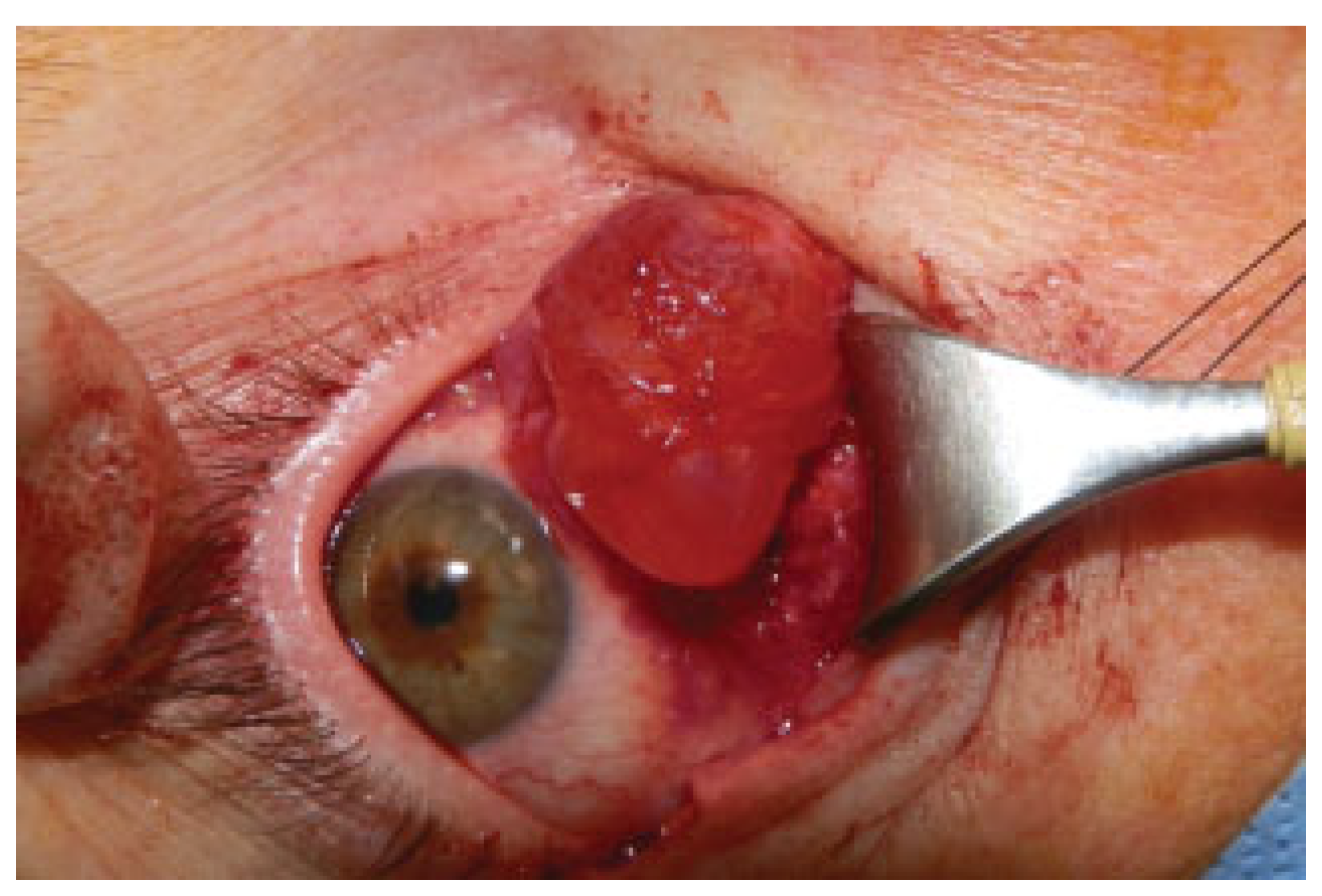
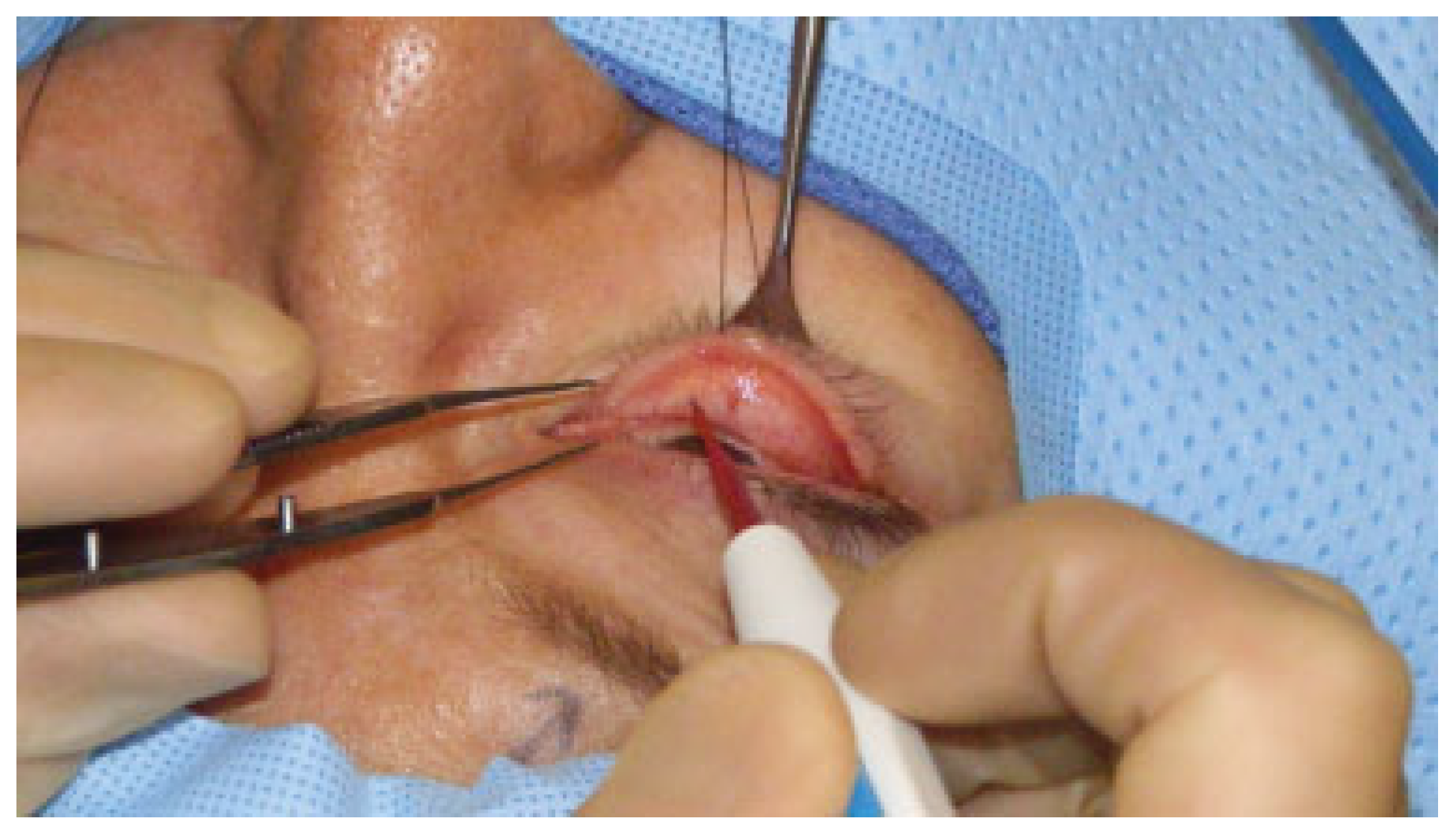
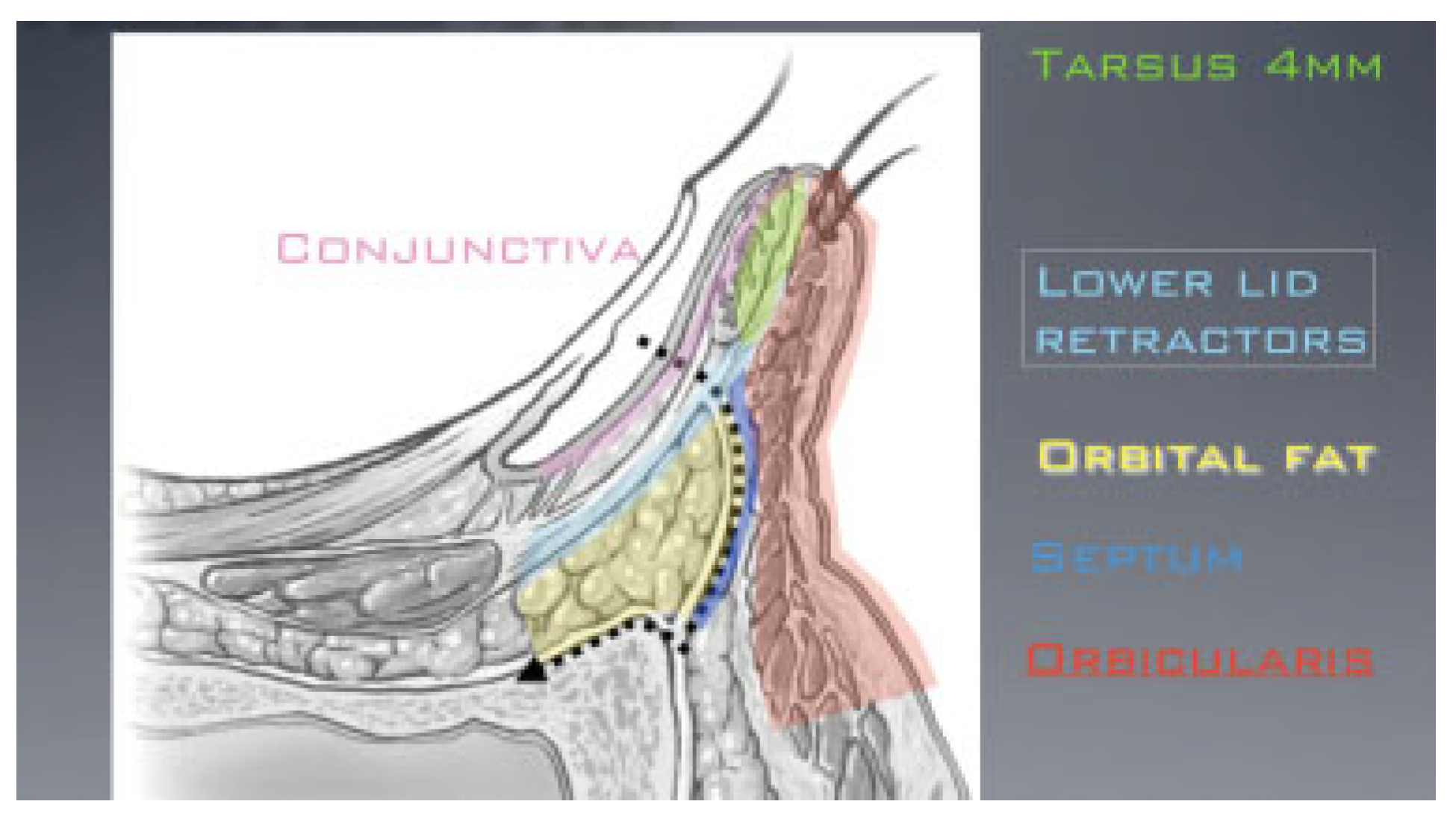
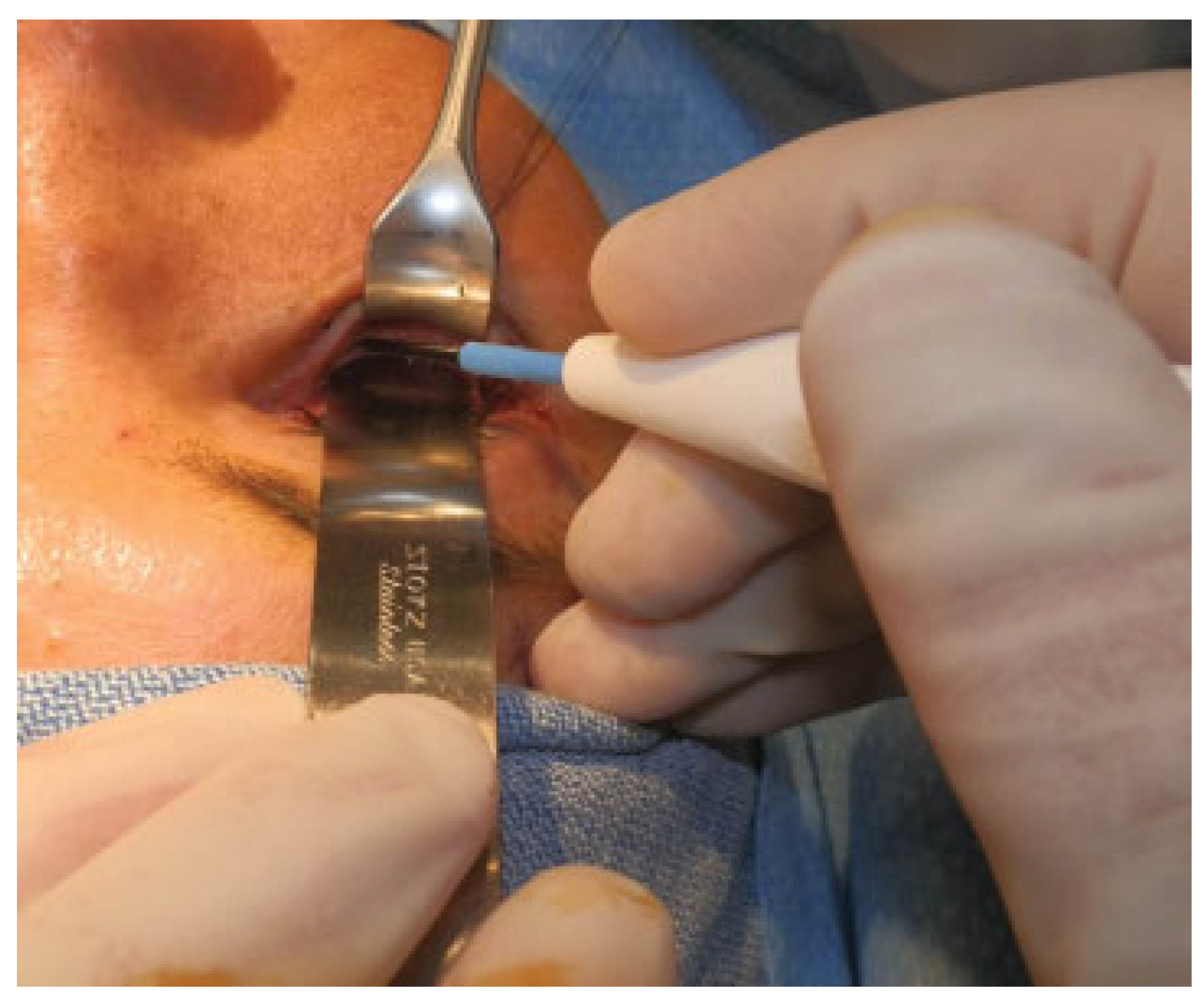
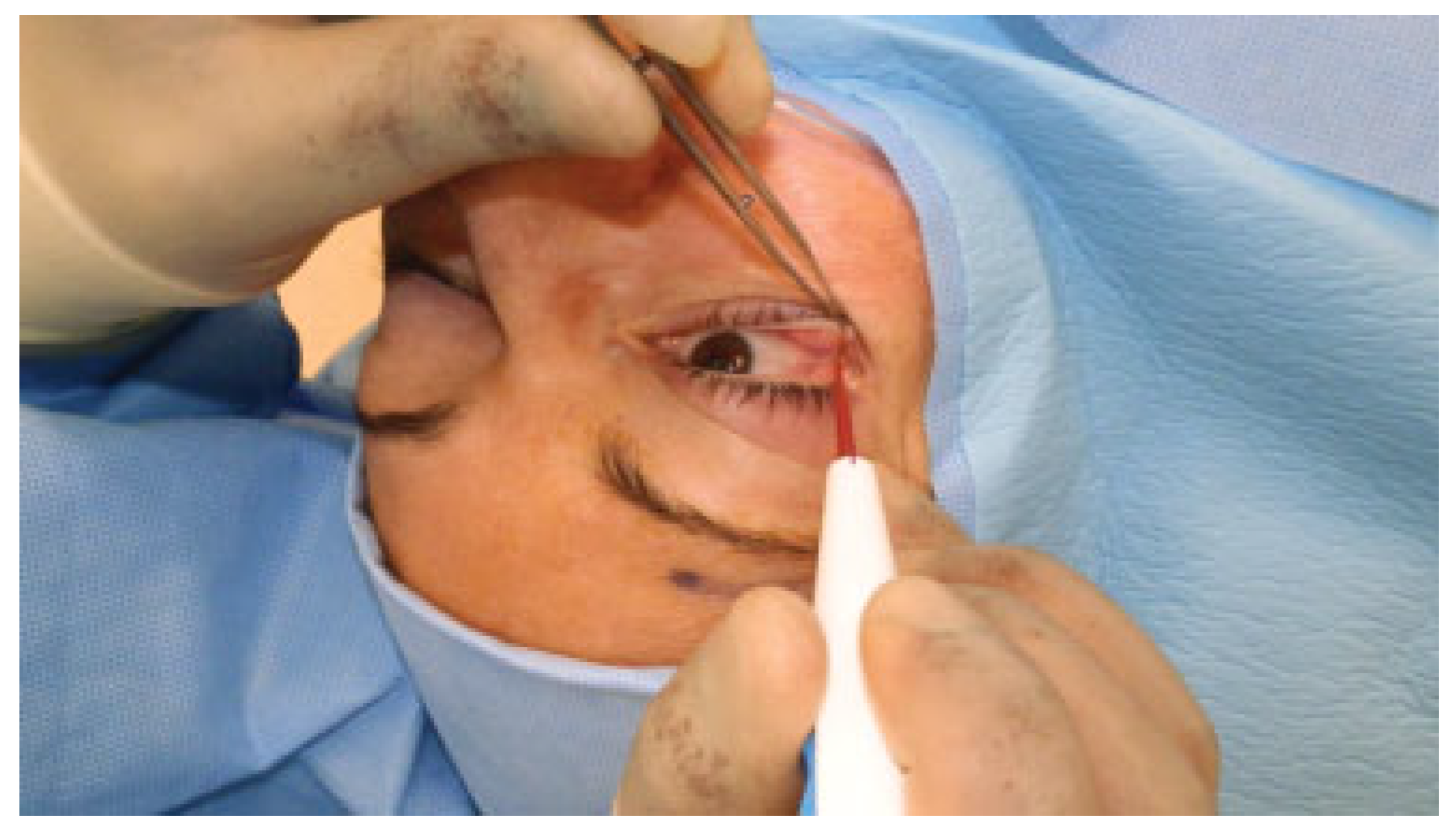

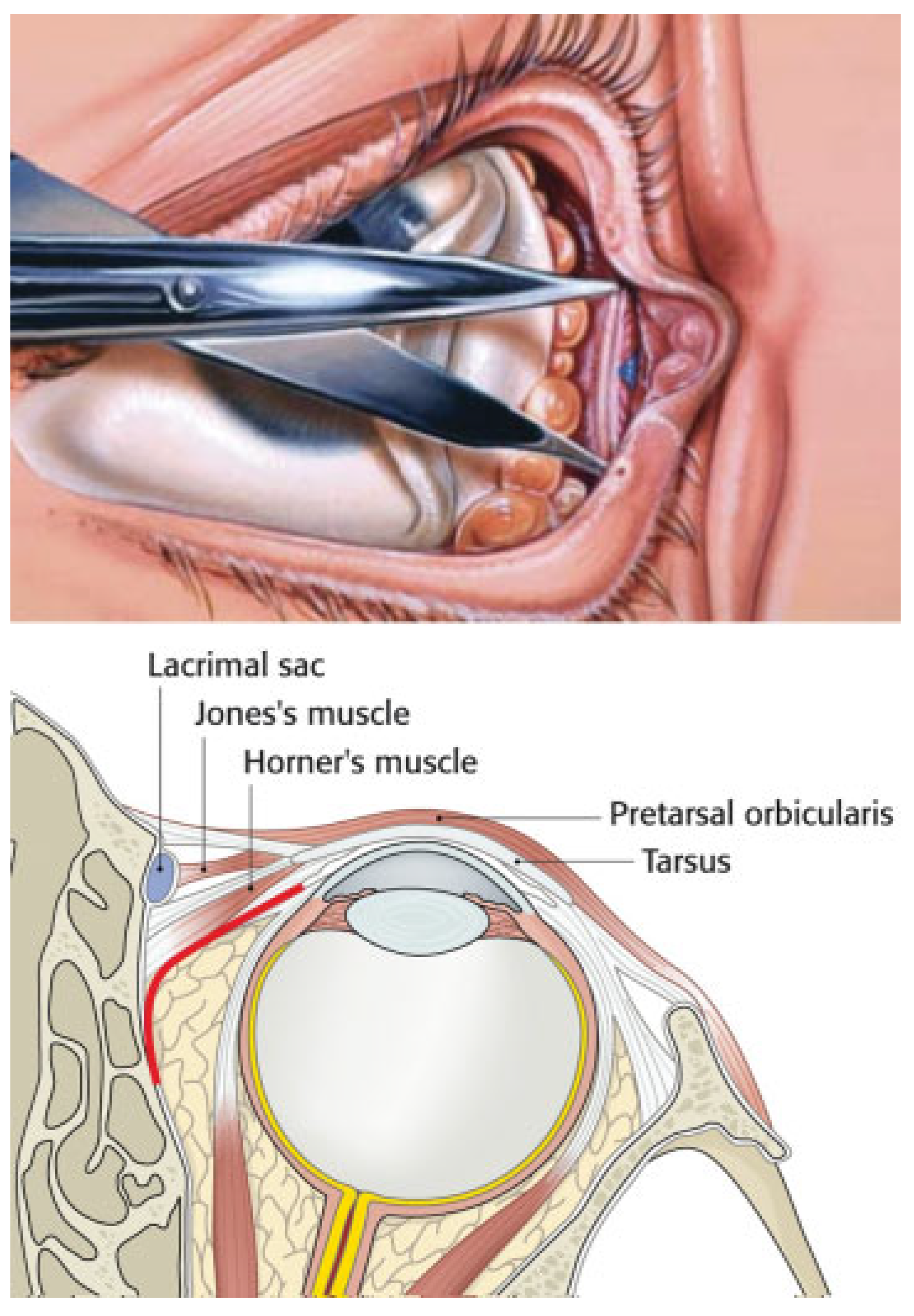

© 2014 by the author. The Author(s) 2014.
Share and Cite
Davies, B.W.; Hink, E.M.; Durairaj, V.D. Transconjunctival Inferior Orbitotomy: Indications, Surgical Technique, and Complications. Craniomaxillofac. Trauma Reconstr. 2014, 7, 169-174. https://doi.org/10.1055/s-0034-1374063
Davies BW, Hink EM, Durairaj VD. Transconjunctival Inferior Orbitotomy: Indications, Surgical Technique, and Complications. Craniomaxillofacial Trauma & Reconstruction. 2014; 7(3):169-174. https://doi.org/10.1055/s-0034-1374063
Chicago/Turabian StyleDavies, Brett W., Eric M. Hink, and Vikram D. Durairaj. 2014. "Transconjunctival Inferior Orbitotomy: Indications, Surgical Technique, and Complications" Craniomaxillofacial Trauma & Reconstruction 7, no. 3: 169-174. https://doi.org/10.1055/s-0034-1374063
APA StyleDavies, B. W., Hink, E. M., & Durairaj, V. D. (2014). Transconjunctival Inferior Orbitotomy: Indications, Surgical Technique, and Complications. Craniomaxillofacial Trauma & Reconstruction, 7(3), 169-174. https://doi.org/10.1055/s-0034-1374063


